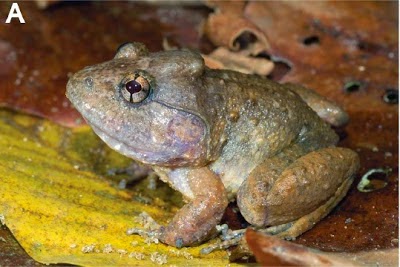Fanged Frogs, Limnonectes
spp., are unique among Frogs in that the males are typically larger than the
females, and frequently fight for territories, the females then mating with the
males perceived as having the best territories in which to lay their eggs, a
reproductive strategy common among Fish and Mammals, but otherwise unknown
among Amphibians. The males show several adaptations to this lifestyle, notably
enlargement of the head, which in extreme cases can comprise half the
body-length, and the development of fang-like protrusions on the lower jaw,
which give the group its common name. The group are known to have undergone a
considerable adaptive radiation on the island of Sulawesi, although the exact
number of species present, as many were originally described as populations of
species described elsewhere, something which is now realized to be erroneous.
In a paper published in the journal PLoS One on 31 December 2014, Djoko Iskandar
of the School of Life Sciences and Technology at Institut Teknologi Bandung, BenEvans of the Center for Environmental Genomics at McMaster University and JimmyMcGuire of the Museum of Vertebrate Zoology, and Department of Integrative Biology at the University of California, Berkeley, describe a new species of
Fanged Frog from Sulawesi Utara, Gorontalo, Sulawesi Tengah, and Sulawesi Barat
Provinces on Sulawesi, i.e. the entire of the Northern Peninsula and the
western part of the Central Core of the island; it may also be present in the
highlands of the interior of the Central Core.
The new species is named Limnonectes larvaepartus,
meaning ‘to give birth to larvae’ in reference to the unique reproductive
strategy of the species. Male adults of the species examined ranged from 39.8
to 44.5 mm, while adult females ranged from 41.2 to 44.3 mm. The Frogs are
typically brownish grey, but may be dark brown, reddish brown or golden tan in
colour, the underside being yellowish or cream. About 23% of specimens examined
had a prominent stripe along the back.
Limnonectes larvaepartus. Male, left, and female, right, collected from Desa Uaemate along
the Tasio-Tibo Road, KabupatanMamuju, Provinsi Sulawesi Barat, Sulawesi Island
(02.61287S, 119.14238 E, 89 m elev.). Iskander et al. (2014).
Limnonectes larvaepartus is unique in that it apparently combines internal fertilization
with the birth of live tadpoles, an otherwise unknown reproductive strategy. A
number of Frog species are known to combine internal fertilization with egg
laying, and members of the African genera Nectophrynoides
and Nimbaphrynoides, as well as the
now extinct Puerto Rican Eleutherodactylus jasperi,
combine internal fertilization with the birth of small adult Frogs, but the
combination of internal fertilization and live birth of tadpoles has not
previously been documented.
The birth of live tadpoles was not actually observed in Limnonectes larvaepartus, however
several female specimens were found to be pregnant with tadpoles, though none
bore Frogs, and several gave birth to viable tadpoles while being handled, and
free living tadpoles were also observed. In the direct developing Eleutherodactylus coqui, the eggs of
which usually develop directly into Frogs, can hatch as tadpoles if the eggs
are disturbed, so potentially Limnonectes larvaepartus
could have a similar strategy, giving birth to tadpoles only when stressed,
however the presence of live free-living tadpoles in the wild, combined with
the absence of any partially metamorphosed Frogs in gravid females, suggests
that this is unlikely.
Newborn tadpoles of Limnonectes larvaepartus. Iskander et
al. (2014).
See also…
 A new species of Treefrog from Madagascar. Treefrogs of the genus Boophis
are found in Madagascar and the Comoros Islands, reaching maximum diversity in
the rainforests of eastern Madagascar. There are over 70 species in the genus,
most of them being fairly recent discoveries. The genus is split into two
subgenera, Boophis, which breeds in...
A new species of Treefrog from Madagascar. Treefrogs of the genus Boophis
are found in Madagascar and the Comoros Islands, reaching maximum diversity in
the rainforests of eastern Madagascar. There are over 70 species in the genus,
most of them being fairly recent discoveries. The genus is split into two
subgenera, Boophis, which breeds in...
Fanged Frogs of the genus Limnonectesget their name from fang-like protrusions on the jaws of the male Frogs. They
are unusual for Frogs in that the males are larger than the females (the
reverse is usually the case), and apparently defend territories through
physical contests with other males, with females mating with...
Fanged Frogs of the genus Limnonectesare found across southern China and Japan, as well as the Philippines,
Southeast Asia and much of Indonesia. They are unusual in that the males are
considerably...
Follow Sciency Thoughts on Facebook.




